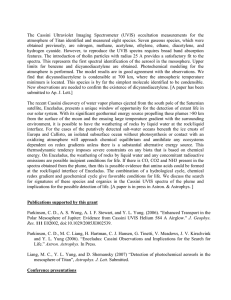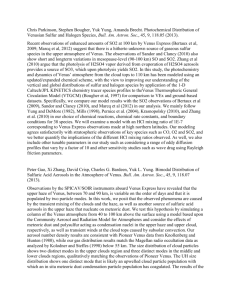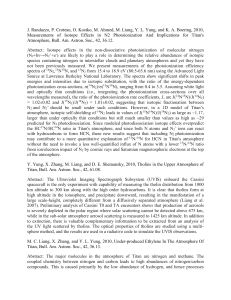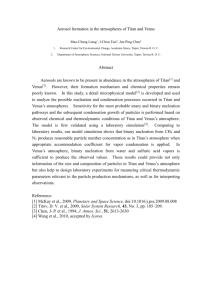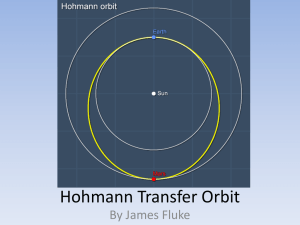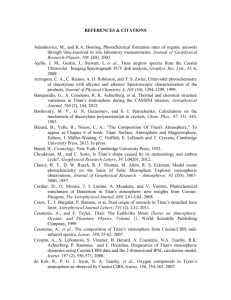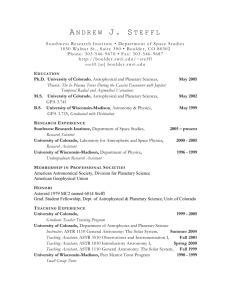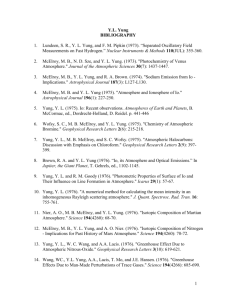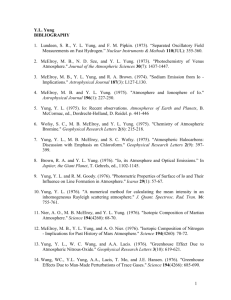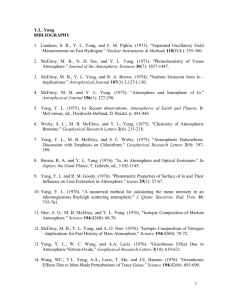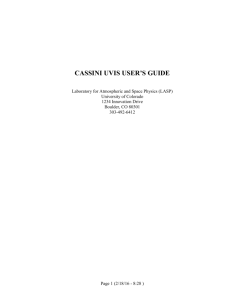DPS_2012_abstract
advertisement
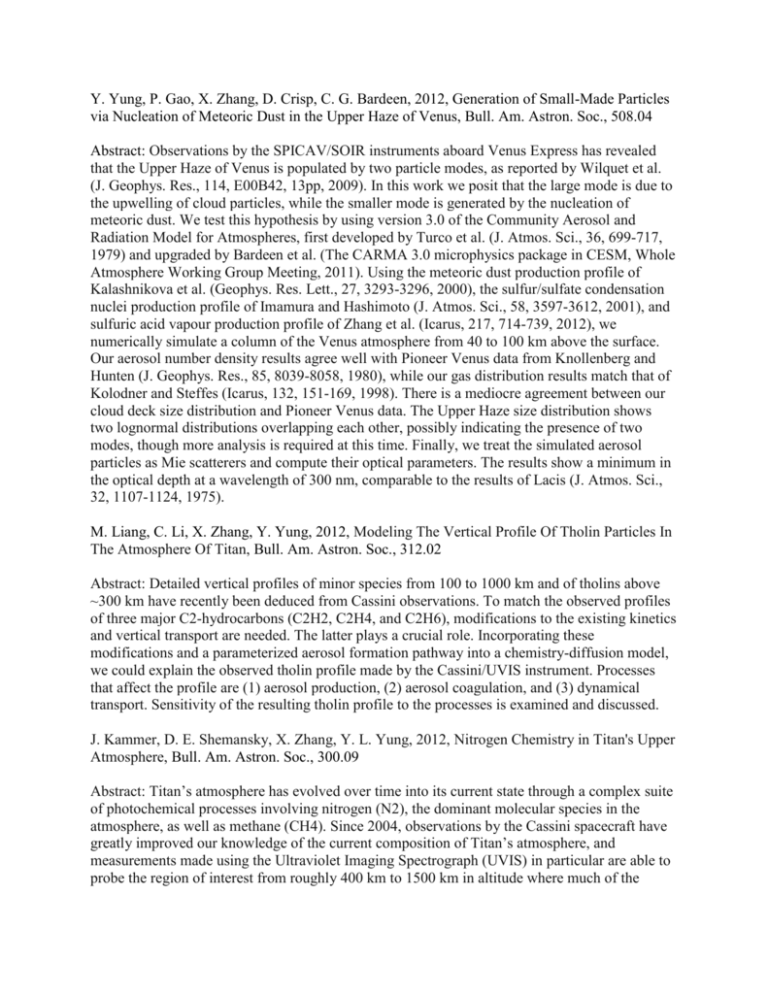
Y. Yung, P. Gao, X. Zhang, D. Crisp, C. G. Bardeen, 2012, Generation of Small-Made Particles via Nucleation of Meteoric Dust in the Upper Haze of Venus, Bull. Am. Astron. Soc., 508.04 Abstract: Observations by the SPICAV/SOIR instruments aboard Venus Express has revealed that the Upper Haze of Venus is populated by two particle modes, as reported by Wilquet et al. (J. Geophys. Res., 114, E00B42, 13pp, 2009). In this work we posit that the large mode is due to the upwelling of cloud particles, while the smaller mode is generated by the nucleation of meteoric dust. We test this hypothesis by using version 3.0 of the Community Aerosol and Radiation Model for Atmospheres, first developed by Turco et al. (J. Atmos. Sci., 36, 699-717, 1979) and upgraded by Bardeen et al. (The CARMA 3.0 microphysics package in CESM, Whole Atmosphere Working Group Meeting, 2011). Using the meteoric dust production profile of Kalashnikova et al. (Geophys. Res. Lett., 27, 3293-3296, 2000), the sulfur/sulfate condensation nuclei production profile of Imamura and Hashimoto (J. Atmos. Sci., 58, 3597-3612, 2001), and sulfuric acid vapour production profile of Zhang et al. (Icarus, 217, 714-739, 2012), we numerically simulate a column of the Venus atmosphere from 40 to 100 km above the surface. Our aerosol number density results agree well with Pioneer Venus data from Knollenberg and Hunten (J. Geophys. Res., 85, 8039-8058, 1980), while our gas distribution results match that of Kolodner and Steffes (Icarus, 132, 151-169, 1998). There is a mediocre agreement between our cloud deck size distribution and Pioneer Venus data. The Upper Haze size distribution shows two lognormal distributions overlapping each other, possibly indicating the presence of two modes, though more analysis is required at this time. Finally, we treat the simulated aerosol particles as Mie scatterers and compute their optical parameters. The results show a minimum in the optical depth at a wavelength of 300 nm, comparable to the results of Lacis (J. Atmos. Sci., 32, 1107-1124, 1975). M. Liang, C. Li, X. Zhang, Y. Yung, 2012, Modeling The Vertical Profile Of Tholin Particles In The Atmosphere Of Titan, Bull. Am. Astron. Soc., 312.02 Abstract: Detailed vertical profiles of minor species from 100 to 1000 km and of tholins above ~300 km have recently been deduced from Cassini observations. To match the observed profiles of three major C2-hydrocarbons (C2H2, C2H4, and C2H6), modifications to the existing kinetics and vertical transport are needed. The latter plays a crucial role. Incorporating these modifications and a parameterized aerosol formation pathway into a chemistry-diffusion model, we could explain the observed tholin profile made by the Cassini/UVIS instrument. Processes that affect the profile are (1) aerosol production, (2) aerosol coagulation, and (3) dynamical transport. Sensitivity of the resulting tholin profile to the processes is examined and discussed. J. Kammer, D. E. Shemansky, X. Zhang, Y. L. Yung, 2012, Nitrogen Chemistry in Titan's Upper Atmosphere, Bull. Am. Astron. Soc., 300.09 Abstract: Titan’s atmosphere has evolved over time into its current state through a complex suite of photochemical processes involving nitrogen (N2), the dominant molecular species in the atmosphere, as well as methane (CH4). Since 2004, observations by the Cassini spacecraft have greatly improved our knowledge of the current composition of Titan’s atmosphere, and measurements made using the Ultraviolet Imaging Spectrograph (UVIS) in particular are able to probe the region of interest from roughly 400 km to 1500 km in altitude where much of the photochemistry on Titan occurs. This photochemistry is responsible for converting nitrogen from stable N2 molecules into other detectable nitrile compounds such as HCN, HC3N, and heavier species that are further processed into tholins. Therefore an analysis of nitrogen and nitrile abundances on Titan is of particular interest, and we examine UVIS solar and stellar occultation observations in both the EUV and FUV regions of the spectrum in order to directly retrieve the vertical profiles of N2 in addition to its related hydrocarbon derivatives. Furthermore, global analysis of these density profiles strongly indicates possible spatial and seasonal variability both for composition and temperature of the upper atmosphere. D. E. Shemansky, X. Zhang, M. Liang, Y. L. Yung, 2012, Properties of the Scattered FUV Solar Spectrum at Titan, Bull. Am. Astron. Soc., 312.14 Abstract: The strong solar reflection spectrum in the FUV in Cassini UVIS observations with line of sight below the solid limb allow the examination of spectral properties of the scattering medium. At wavelengths longward of 1525 A the spectrum is characterized mainly by solar emission structure. Absorption features in acetylene , the main known absorber in this region, are weak. The spectrum therefore shows the properties of a Rayleigh scattering continuum in a wavelength range of 1920. - 1525.1 A, below which the solar continuum and line emissions are cut-off by absorption in the medium. The observed emission is evidently multiply scattered. At a line of sight altitude of 1040 km, analysis assuming Mie scattering gives an estimated particle radius of 76 A. The evident strong absorber at lower altitude giving the sharp extinction of the emission spectrum below 1525 A needs investigation. The PAH naphthalene, with an ionization potential of 1526.9 A is the nearest candidate identified to date. The spectral properties of the scattering medium in the 1920. - 1525.1 A region will be described. X. Zhang, C. A. Nixon, R. Shia, R. A. West, R. Morales-Juberias, R. Cosentino, P. G. Irwin, T. Dowling, M. A. Allen, Y. L. Yung, 2012, Radiative Forcing of the Stratosphere of Jupiter from Cassini Observations, Bull. Am. Astron. Soc., 205.05 Abstract: In this study we present a detailed analysis of the instantaneous zonally averaged radiative forcing of the Jovian stratosphere during the Cassini flyby in Dec. 2000. It provides the necessary data for an accurate simulation of the state of the stratosphere of Jupiter. First, we retrieved the global map of stratospheric temperature field and hydrocarbon species based on the measurements from the Cassini Composite Infrared Spectrometer (CIRS). The associated uncertainties are carefully characterized. From the simultaneous observations by the multiple filters of Cassini Imaging Science Subsystem (ISS), a global map of stratospheric aerosol is obtained via a nonlinear optimization approach. Large difference between the scattering properties of aerosols and clouds in the equatorial region and polar region indicate different types of aerosol and clouds in the two regions. Secondly, based on the retrieved data, a line-by-line radiative transfer model including the Non-LTE effect is introduced to calculate the solar heating and mid-infrared cooling rates for each latitude and altitude. The fractal aggregated multisphere particles with monomer radius of tens of nanometers contribute to the heat source in the upper stratosphere of the polar region. Finally, preliminary results of a stratospheric circulation model driven by the radiative forcing and a two-dimensional chemical transport model forced by the circulation will be presented. C. Li, X. Zhang, J. A. Kammer, M. C. Liang, Y. L. Yung, 2012, Revisiting the Photochemical Processes on Titan: Insight from Cassini Observations, Bull. Am. Astron. Soc., 300.06 Abstract: The recent measurements from the nadir-view and limb-view soundings of Cassini/CIRS (Vinatier et al., 2010) and the stellar occultations from Cassini/UVIS (Kammer et al., 2010, Koskinen et al., 2011) revealed the complete vertical profiles of minor species (mainly C2H2 and C2H4) from 100 to 1000 km in the atmosphere of Titan. In this study, we introduce a new eddy diffusivity profile and revise the rate coefficients for the chemistry of hydrocarbons, especially for C2H4. Our new results are in better agreement with the new Cassini measurements than the previous 1D chemistry-diffusion models (e.g., Yung et al., 1984; Lavvas et al., 2008 a, b; Krasnopolsky, 2010). An inversion technique is developed to retrieve the vertical profile of eddy diffusivity. We use the abundance of C2H2 as a proxy to retrieve the eddy diffusivity profile and verify it though the chemistry-diffusion modeling of other tracers. We found that the new eddy profile features a turnover near the altitude of detached haze layer (~550 km), which might lead to the formation of the detached haze layer through a potential positive feedback process. Secondly, the same retrieval method is applied to the chemistry of C2H4. The result suggests a revision of rate coefficients for the three body reactions of C2H4 so as to keep the simulated profile close to the observation. The revised rate coefficients will also be used and tested for the hydrocarbon chemistry on giant planets. M. R. Line, E. Ellison, X. Zhang, Y. Yung, 2012, Secondary Eclipse Spectral Retrievals: Trends in Chemistry, Bull. Am. Astron. Soc., 103.03 Secondary eclipse spectra of exoplanets probe the thermal emission of the atmosphere and can therefore tell us about their composition and temperature. Here we will apply the optimal estimation retrieval approach (Lee et al. 2012, Line et al. 2012) to all available secondary eclipse spectra (in some cases multiple data sets per planet) in order to identify compositional trends amongst different atmospheres, such as the CH4/CO ratio as a function of effective temperature etc. We will compare our retrieved results to what is expected from thermal equilibrium chemistry in order to assess how strongly out of equilibrium the planets as a whole agree with or deviate from thermal equilibrium.
